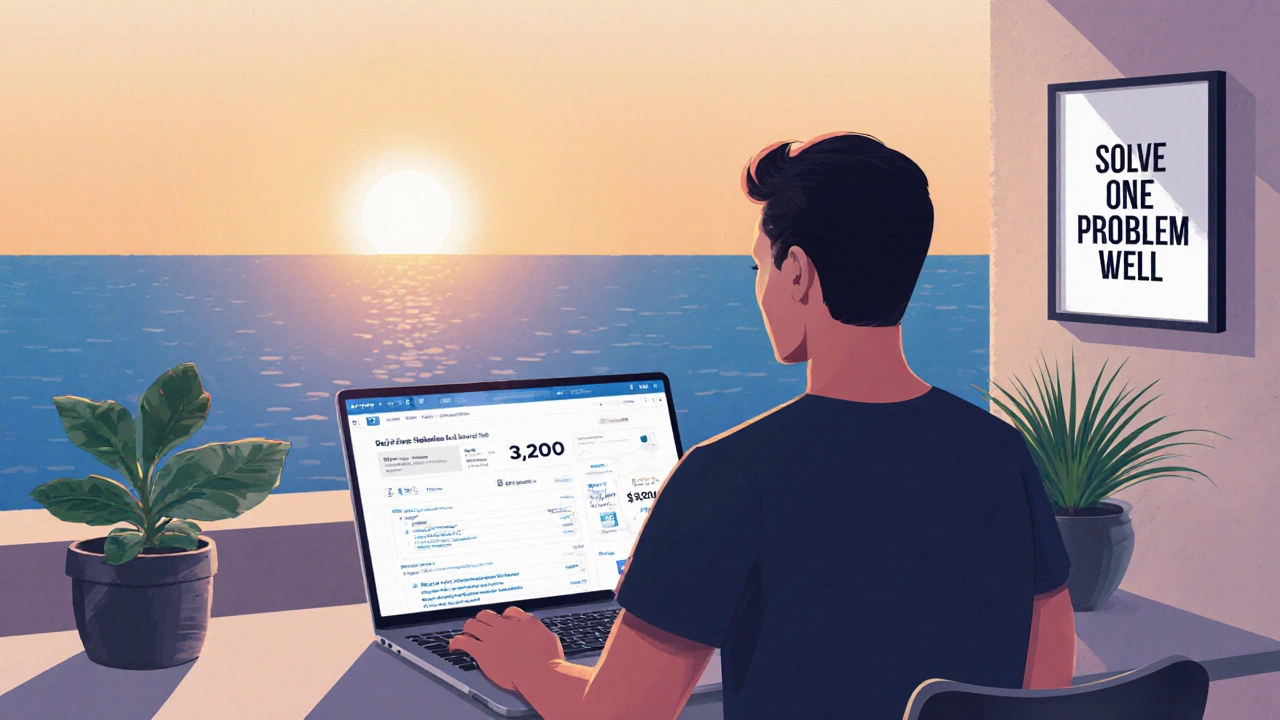There’s a myth floating around that anyone can get rich overnight by selling drop-shipped socks or running a TikTok account. But the truth? The people making the most money online aren’t chasing viral trends. They’re building systems-scalable, repeatable, and often invisible to the average person. If you’re wondering who’s actually pulling in six or seven figures online right now, the answer isn’t a mystery. It’s a pattern.
Online Course Creators and Educators
One of the most consistent high earners online are people who teach skills others are desperate to learn. Think of someone who built a $200 course on advanced Excel automation for accountants. They sell it to 500 people a month. That’s $100,000 a month. No inventory. No shipping. Just a recorded video, a landing page, and an email sequence.
Platforms like Teachable, Podia, and Kajabi make this easy. But the real differentiator? Niche specificity. A course called "How to Use Canva for Small Business Owners" makes less than "How to Design Instagram Posts That Convert for Local Dentists in Texas." The more specific the audience, the higher the price and the less competition.
In 2025, online course creators who focus on professional certifications-like Google Ads certification prep, QuickBooks training for freelancers, or AI prompt engineering for marketers-are seeing average sales of $500-$2,000 per student. Some top creators in this space make over $1 million a year, not because they’re famous, but because they solve urgent, paid problems.
Affiliate Marketers in High-Ticket Niches
Affiliate marketing isn’t dead. It’s just evolved. The people making serious money now aren’t linking to Amazon products. They’re promoting software tools with $500-$5,000 monthly subscriptions.
For example, an affiliate marketer who writes detailed reviews of CRM platforms like HubSpot or Salesforce can earn $1,000-$5,000 per sale. If they convert just one sale a week, that’s $52,000 to $260,000 a year. Do that consistently across three platforms, and you’re looking at a six-figure income with minimal overhead.
These marketers don’t rely on traffic from TikTok. They build authority through long-form content: YouTube tutorials, detailed blog posts, and email newsletters. One top affiliate in the SaaS space told me they spend 80% of their time creating content that answers one question: "Is this tool worth $2,000 a year?" That’s the question businesses are asking-and they’re willing to pay for honest answers.
Private Digital Product Sellers
Not all digital products are courses. Some of the highest earners sell templates, tools, and downloadable assets that solve very specific problems. Think of a Shopify store owner who created a $97 template pack for fashion brands: product photography layouts, email sequences for cart abandonment, and Instagram story templates. They sold 8,000 copies in 18 months. That’s $776,000 in revenue.
These sellers use platforms like Gumroad, Etsy, or even their own websites. The key? They don’t sell "everything." They sell one thing, really well, to one group of people. A graphic designer made $300,000 last year selling Notion templates for freelance copywriters. Another made $1.2 million selling automated Excel sheets for real estate investors.
The secret? These aren’t flashy products. They’re time-savers. People pay for them because they save 10-20 hours a week. And when you’re a busy professional, your time is worth more than the price tag.

YouTube Creators with Monetized Channels
YouTube isn’t just for kids doing challenges. The most profitable channels in 2025 are built around education, reviews, and how-to content in high-value niches. Think: "How to file taxes as a freelancer," "Best accounting software for e-commerce," or "How to get a business loan with bad credit."
These creators earn through a mix of AdSense, sponsorships, and product promotions. A channel with 50,000 monthly views in a financial niche can earn $3-$8 per 1,000 views from ads-because financial advertisers pay more. Add in a single sponsor for a product like QuickBooks or Stripe, and that’s another $5,000-$20,000 per video.
One creator I tracked made $412,000 last year from YouTube alone. His channel had 1.2 million subscribers, but only 12 videos. He didn’t post weekly. He posted once every six weeks-and each video was a 30-minute deep dive. His audience didn’t come for entertainment. They came for answers they couldn’t find anywhere else.
Private SaaS and Software Tools
The highest earners online aren’t just selling to consumers. They’re selling to businesses. And the most profitable businesses online in 2025 are micro-SaaS tools-small software products that solve one problem really well.
Take a tool like "Invoice Ninja," which helps freelancers create and send invoices. It started as a side project. Now it has over 1 million users and makes $20 million a year. Or "Loom," the screen recording tool. It was built by one person, then scaled. Today, it’s worth hundreds of millions.
You don’t need a team of developers to start. Many successful micro-SaaS tools are built with no-code platforms like Bubble, Glide, or Softr. One developer in Australia built a tool that auto-fills government forms for small businesses. He charges $29/month. He has 3,200 paying users. That’s $92,800 a month. He works 20 hours a week.
The real advantage? Recurring revenue. Once you have 1,000 users paying $50 a month, you’ve got $600,000 a year-without ever having to sell another thing.
Why Most People Don’t Make It
Here’s the uncomfortable truth: most people trying to "make money online" fail because they’re chasing speed, not scale. They want quick wins. But the people who win online invest in systems that compound.
It’s not about having the best idea. It’s about solving a real problem for a group of people who already have money to spend. A $500 course for dental hygienists will sell better than a $10 course for "everyone." A $200/month tool for real estate agents will outperform a free app for hobbyists.
The biggest mistake? Trying to appeal to everyone. The winners focus on one audience. One problem. One solution. And they refine it until it’s indispensable.

What You Can Start Today
If you want to join the top earners, here’s where to begin:
- Find a group of people who are already spending money online-freelancers, small business owners, coaches, real estate agents.
- Ask them: "What’s the one thing you wish someone would just fix for you?" Listen. Don’t guess.
- Create a simple solution: a PDF guide, a Notion template, a 15-minute video tutorial.
- Sell it to 10 people. Ask for feedback. Improve it.
- Scale it. Turn it into a course, a tool, or a subscription.
You don’t need to be an expert. You just need to be one step ahead of the person asking the question.
Real Numbers, Real Results
Let’s be clear: making $100,000 a year online isn’t rare anymore. It’s common among people who treat it like a business-not a side hustle. Here’s what that looks like:
- One course creator: $87,000/month from a single course sold to 400 people at $217 each.
- One affiliate marketer: $68,000/month from promoting three SaaS tools with 15% commissions.
- One micro-SaaS founder: $92,000/month from 3,200 users paying $29/month.
- One YouTube channel: $38,000/month from ads, sponsorships, and digital products.
These aren’t outliers. They’re people who showed up, consistently, for two years. They didn’t quit when nothing happened in the first 30 days. They kept refining.
Can you really make six figures online without a team?
Yes. Many of the highest earners run solo businesses. A micro-SaaS founder with 3,000 users paying $30/month makes $1.08 million a year without hiring anyone. The key is using automation and no-code tools to handle scaling. You don’t need employees-you need systems.
Is affiliate marketing still profitable in 2025?
Absolutely-but only if you focus on high-ticket products. Promoting Amazon products won’t make you rich. But promoting a $2,000 CRM tool with a 30% commission? That’s a $600 payout per sale. If you convert just one sale a week, you’re making $31,200 a year. Top affiliates make $50,000-$200,000 monthly by targeting B2B software buyers.
Do you need a website to make money online?
Not always, but you need a place to own your audience. Social media platforms can take down your account or change their algorithm overnight. A website-even a simple landing page on Carrd or Gumroad-gives you control. It’s your digital real estate. Without it, you’re renting space. With it, you’re building equity.
What’s the fastest way to make money online in 2025?
Sell a digital product you already know how to create. If you’ve ever helped someone with Excel, Canva, or budgeting, turn that into a $20-$50 guide. Sell it to 100 people. That’s $2,000-$5,000 in a week. No ads needed. Just share it in Facebook groups or Reddit threads where your audience already hangs out.
Are online courses still worth it?
Only if they’re specific and solve a real pain point. Generic courses like "Make Money Online" don’t sell. But a course titled "How to Get Your First 10 Clients as a Virtual Assistant in Australia"? That sells fast. People pay for clarity, not inspiration. The more targeted, the higher the price-and the better the conversion.
Final Thought: It’s Not About Luck
The people making the most money online aren’t lucky. They’re focused. They didn’t wait for the perfect idea. They started with what they knew, tested it, and kept improving. They didn’t chase trends. They built products for people who were already paying for solutions.
If you want to be one of them, stop looking for shortcuts. Start solving real problems. One small step at a time.

